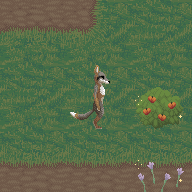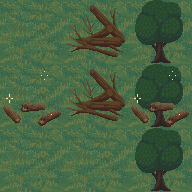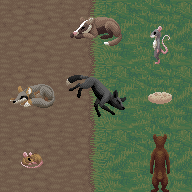Lore
When creating a character for Farwoods, it may help for you to know exactly what kind of setting you are placing them into! Farwoods is a fantasy setting, where walking, talking forest critters of approximately the same size as their Earth counterparts inhabit the land. There are no human beings in Farwoods, nor were there ever, and the world is unlike our own. The game is primarily set on Kalris, a relatively large island geographically isolated from other civilizations. You can find more detailed lore in books in the game itself.
Kalris
(top)Kalris was once home to a great civilization, the likes of which had never been seen by critters before or since. It was a grand, technologically advanced empire that sprawled the whole of Kalris. This empire was democratic and magnimonious, and accommodated many immigrants from the less civilized lands across the sea, which were known as the Old World to foreign-born citizens, and eventually to all Kalrisians. The empire employed in its society inventions which were unheard of in the Old World — in fact, the concept of critters of different species working together was itself largely unheard of in the Old World. Yet, in the empire, the strong and weak alike worked side by side without animosity or violence.
Though the empire is long gone today, what remains suggests that it existed for a very long time. Even today, many Kalrisians are the descendants of citizens of the empire, though they have largely forgotten their traditions and customs. The exact cause of the empire's decline, and even the very name it called itself, is no longer known by any but the most esoteric historians, but it seems likely that some sort of civil war or uprising led to massive unrest that split the fabric of its society apart and turned critter against critter. Whatever the cause, much of the infrastructure of the empire was reduced to ruins and rubble, and the remainder has languished and decayed in the intervening years. Today it is simply called the Kalrisian Empire, or the Ancient Empire, or a combination of the two.
The people of the empire appear to have been driven into hiding during its decline, exacerbating the lack of historical record or maintenance of ancient structures from the time. The grand cooperation that was unique to the empire dried up, and its former citizens and their descendants gradually returned to tribalistic ways. Its most lasting achievement appears to be its national tongue, known as Kalrisian Common, or simply Common. Designed to be easy to speak by members of any species, it spread well beyond the borders of the empire, and remains in widespread usage on Kalris today, and even across large portions of the Old World. Many critters the world over are raised from birth to speak Common alongside their native tongue, even those who have never heard of Kalris.
The other lasting achievement of the empire is the Morenth Library, a massive structure and wonder of the world in which all new characters start. During the days of the empire, scholars would travel from all over the island to take books from its shelves and add their own, and many still do. It is considered one of the most important and best-preserved landmarks on Kalris, and the sanctity of its interior is beyond reproach by even the freshest critters off the boats. It operates to this day as a safe haven for critters and a place for knowledge, though its inhabitants have always been and remain transitory.
Immigrants from the Old World continued to arrive, but they found nothing like the glorious society that was promised to them across the seas. Most characters in Farwoods are likely to be recent immigrants or the children of recent immigrants, with a smaller number of established family lines dating back to the empire's decline or even the descendants of imperial citizens.
Old World
(top)As Kalris has changed since the glory days of the empire, so too has the Old World. In the earliest days of the empire, the Old World was a land of savage animals, fear, and barbarism. Even the technology that has widely survived the empire's fall was unheard of in the Old World then, and critters lived according to passion and base instinct. Murder, and the consumption of dead flesh, which has been etched so deeply as taboo into the Kalrisian psyche that it remains unheard of to this day, was commonplace in the Old World then. Critters often fled across the sea to escape the cycle of life and death and find more meaningful purpose, and the empire welcomed them with open arms.
Even something as simple as a building made of logs or stone was a wonder to immigrants from the Old World at that time, so the sight of grand imperial designs had a profound effect on new arrivals. As time went on, the innovations of the empire eventually made their way to the Old World: cooking, woodworking, smithing, reading and writing, clothing, Common, et cetera. Some even say that the empire invented magic, and there is no evidence that it was practiced in the Old World at the time. However, any magic used by the empire is likely to have been so much more advanced than the disciplines practiced today that it is unrecognizable.
Unfortunately, without the strength of diversity and cooperation present in the Ancient Empire, the secrets to these astounding technologies did not improve conditions in the Old World. While flesh-eating became less common, to the point that all but the most obscure species evolved to become at least omnivorous, cruelty beyond the conception of animal instinct became widespread. The spread of Common allowed animals from different species to understand each other, but this was mostly used by stronger species to subjugate those without the means to defend themselves. Smithing allowed systems of currency to develop, creating perverse incentives to exploit other critters for profit.
The spread of arms and armor initially equalized the disparity in power between prey and predators, but eventually exacerbated it as they were adopted by predator species themselves. This is all to say, conditions in the Old World were and remain miserable to this day, even now that civilization is more widespread across it, and wherever word of Kalris's existence spread there were those willing to sacrifice everything to undertake the journey. Even long after the empire ceased to exist, Kalris represents a significant improvement in quality of life for most immigrants.
There remain large swathes of the Old World mostly or entirely untouched by the inventions of Kalris. Critters that do not speak Common still frequently interact with those who do, as they were not raised to speak it, and while fantastically useful the language is difficult to learn without being brought up in it.
Imperial Pantheon
(top)The Kalrisian Empire was first founded with the assistance of some native inhabitants of the island &emdash nine dragons which came to be given a place in the Imperial Pantheon for their godlike powers. The first was Il-Tira, the mother goddess and god of magic and prophecy. She gifted the early Kalrisians with the secret of quartz and taught them to wield magic. She also enlisted the help of her kin, normally indifferent to the affairs of smaller critters, such as Elyenne, goddess of the moon and the stars, who gave them the language of Common to allow all species to communicate freely, and Silvanus, goddess of snow and winter, who taught them to weave tangle blossoms into cloth to create clothing and equipment, as well as Dharasi, god of the sun and the sands, who gave the Kalrisians the secret art of metalworking that allowed them to defend themselves from their primitive foes.
Also among the pantheon is Morothi, god of the night, music, and troublemakers, and Althas, god of the seas and weather, whose favor allowed the Empire to become prolific traders and spread their ideology and technology into the Old World. The dragon god Jyra-Tul helped them establish order and self-government and keep the peace through troubled times. The goddess Cerridwen of forests and the harvest kept them in tune with nature and the island bountiful, and the goddess Velyra of love, pleasure, and hospitality encouraged them to enjoy life and treat each other with kindness.
This pantheon is well-known among natives of Kalris and its worship has survived the Empire's decline, as have the dragons themselves. It is common for critters on Kalris to appeal to and cite the dragon gods and receive boons from them. It is also known of across the Common-speaking parts of the Old World, but not as commonly practiced, in some places fallen out of favor for ancient belief systems, animism, physiolatry, and any others you'd care to come up with for the backstory of an Old World character.
Followers of the Pantheon recognize three primary tenets of worship: veneration, enshrinement, and tribute, in order of their relevance. Veneration is the first and most important form of worship. It is as simple as acknowledging the gods' existence. Worshippers venerate the gods by referencing them by name where appropriate (e.g. attributing rain to Althas, ore to Dharasi, magic to Il-Tira, etc.), invoking them, appealing to them, and living according to their values. The most devout worshippers of the Pantheon know the names of all the gods by heart and mention them frequently.
Enshrinement is the second form of worship, which entails creating places of worship to specific gods. Most commonly, these take the form of small burrow shrines with a collection of candles colored to symbolize a dragon. The upkeep of these candles represents a devotion to the god in question, and is believed to greatly improve your favor with them as long as the worship is maintained. Finally, tribute is the third and least common form of worship. This represents a giving up of useful goods to the gods as appeals for their benefaction, or thanks for their favor. The more valuable the sacrifice, the more likely that the gods will take notice. (It should be obvious that they do not accept critter sacrifice, since murder is expressly forbidden by the Pantheon.)
Worshippers of the Pantheon know that while they take a keener interest in the affairs of critters than other dragons, they are enigmatic, elusive, and rarely straightforward. Most messages from the gods come in the form of omens, good or bad, which may appear anywhere, at any time. Devout worshippers are constantly on the lookout for messages that the gods might be sending them. The sudden arrival or ending of rain might be an omen from Althas; an unexpected robbery an omen from Morothi; a poor harvest an omen from Ceridwen; the reappearance of a friend an omen from Velyra, and so on. Attention to omens is a test for the faithful, and they will be rewarded for spotting them with good fortune and preparation for disaster.
Finally, every worshipper of the Pantheon has a patron dragon. While the Pantheon is worshipped in its entirety by its followers, one specific dragon usually calls to a critter more than others. A desert-dwelling critter might take Dharasi as a patron, a watchman might take Jyra-Tul or Velyra (because she is the goddess of truth and inspiration), a thief might take Morothi, a scribe Elyenne, a gardener Cerridwen, and so on. Whichever god a critter can most relate to is their patron, and worshipped ahead of all the others... but not to their exclusion.













